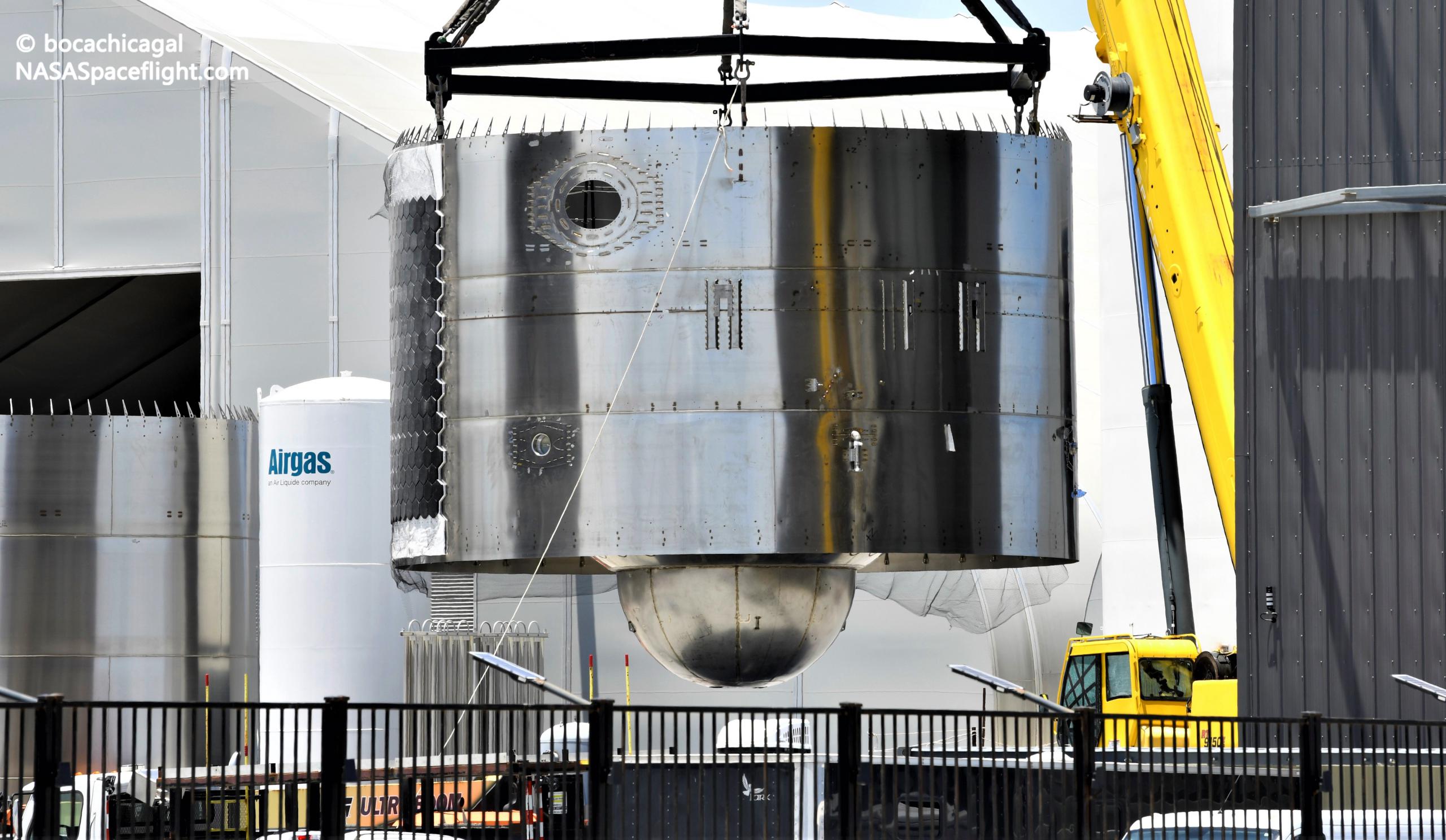
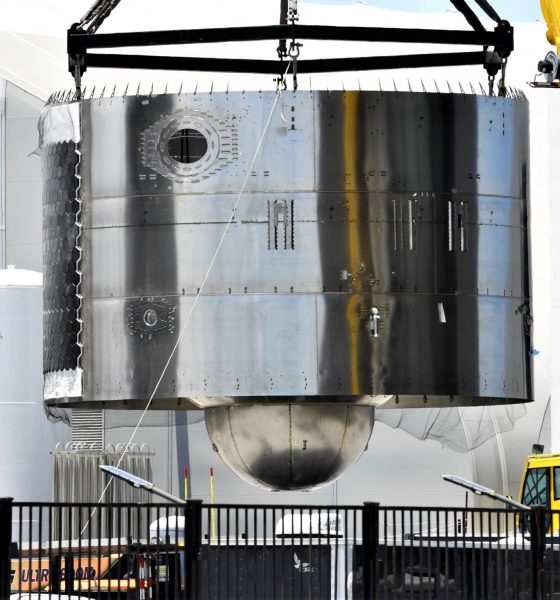
News
SpaceX begins assembling first orbital Starship and Super Heavy booster
SpaceX has begun rapidly assembling the first orbital Starship prototype and the Super Heavy booster set to launch it isn’t far behind.
SpaceX’s Boca Chica, Texas rocket factory seemingly turned a corner in early July as sections of Starship 20 (S20) began to pop up around the site. Though parts labeled Starship “SN20” first appeared as far back as March 2021, the only unequivocal work on SpaceX’s first purportedly orbital-class Starship began in mid-June with the integration of the first engine section with mounts for six – not three – Raptors.
However, in line with SpaceX’s strict focus on maximizing the speed of Starship development and shortening the path to orbit, the company has frequently built Starship hardware before firmly assigning that hardware to any given ship, booster, or tank. In other words, until SpaceX actually begins stacking multiple completed rocket sections, there’s always a degree of uncertainty about the fate of any given ring, dome, or tank barrel. With Starship S20, that process began earlier this month and Super Heavy Booster 4 is likely to follow suit within the next few days – if it hasn’t already.
Since SpaceX unceremoniously rolled Starship prototype SN16 to an empty lot in mid-May, the company didn’t stack a single Starship part until the first week of July – unusual after a frenetic seven months spent building, qualifying, and launching Starships SN8, SN9, SN10, SN11, and SN15 and testing test tanks SN7.2 and BN2.1. Around the same time as Starship SN15 became the first prototype to successfully complete a high-altitude test flight and land in one piece, news broke that SpaceX was striving to perform Starship’s first orbital test flight with Ship 20 (S20) and Booster 3 (B3) as early as July.
Eventually, Booster 3’s orbital launch assignment shifted to Booster 4 as it became clear that the former prototype wasn’t meant to fly, but Starship S20 remained. More likely than not, the almost two-month gap between Starship SN16’s instant retirement and the start of the next flightworthy prototype’s assembly can be explained by the significant changes, upgrades, and undecided design decisions required to jump to S20.
Beyond the need for a thrust structure capable of supporting three sea-level Raptors and three vacuum-optimized engines, Starship S20 would need a full heat shield with thousands of tiles; orbital-class communications and avionics; and the general polished fit and finish required for an orbital launch attempt to have a good shot at producing the data needed for it to be valuable. SpaceX appeared to conclude that those stars were aligned in early July.
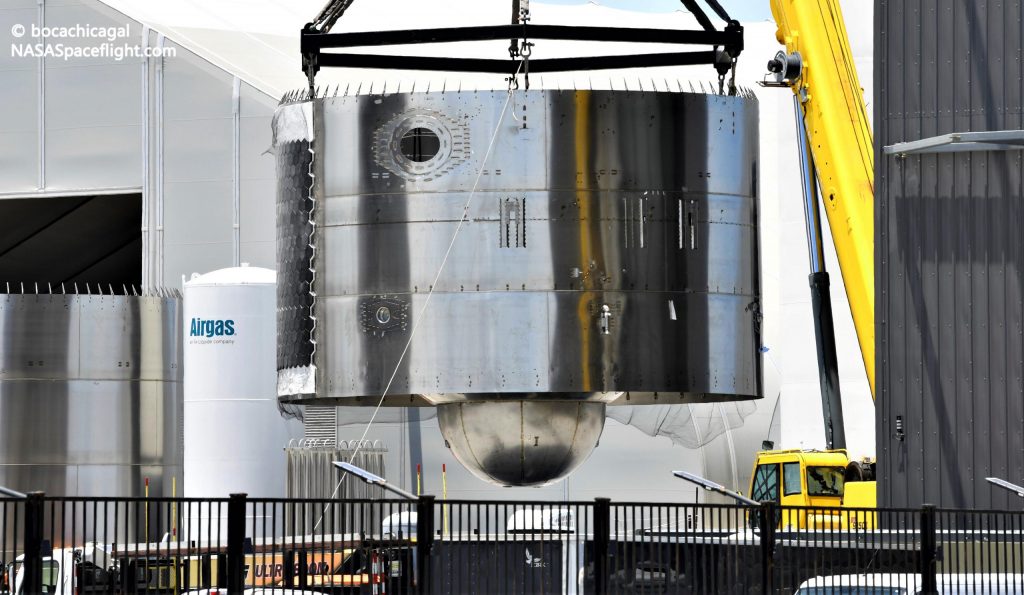
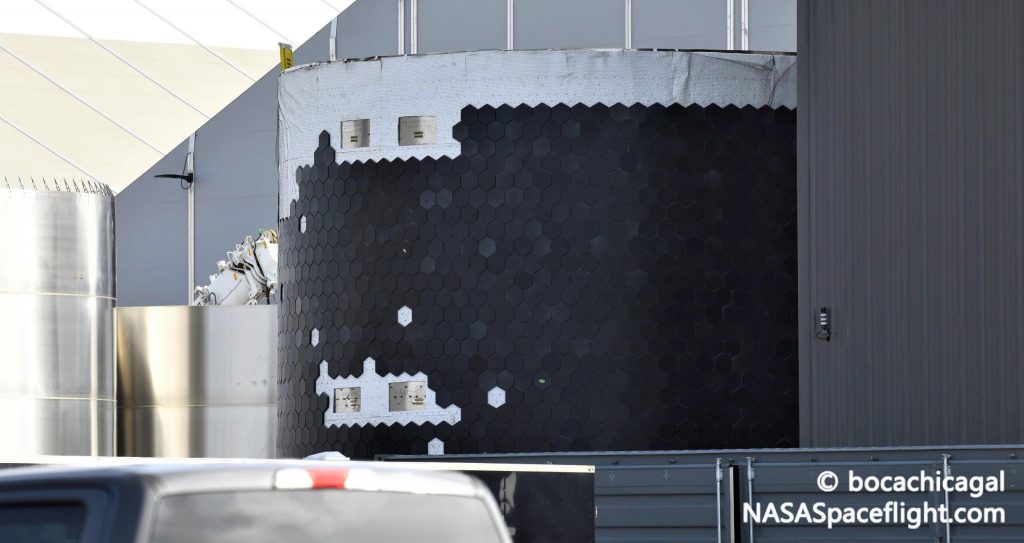
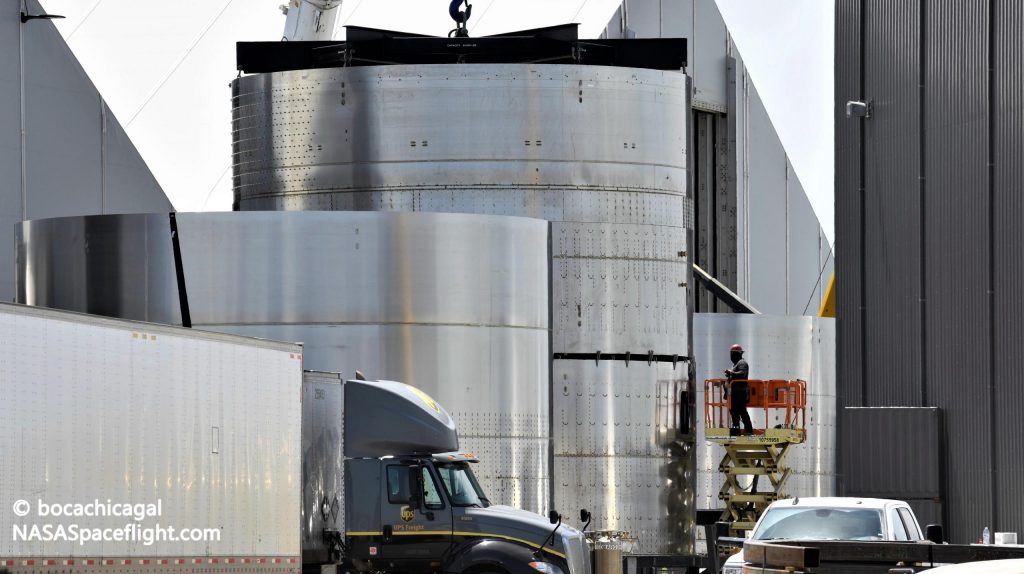
Two weeks after the first stack, Starship S20 is already approximately half-assembled and the last section of the vehicle’s tanks is almost ready for installation. What could be Starship S20’s nosecone is also in the late stages of assembly, though SpaceX has yet to even attempt to fully cover a nose in heat shield tiles and getting that process right could take an attempt or two.
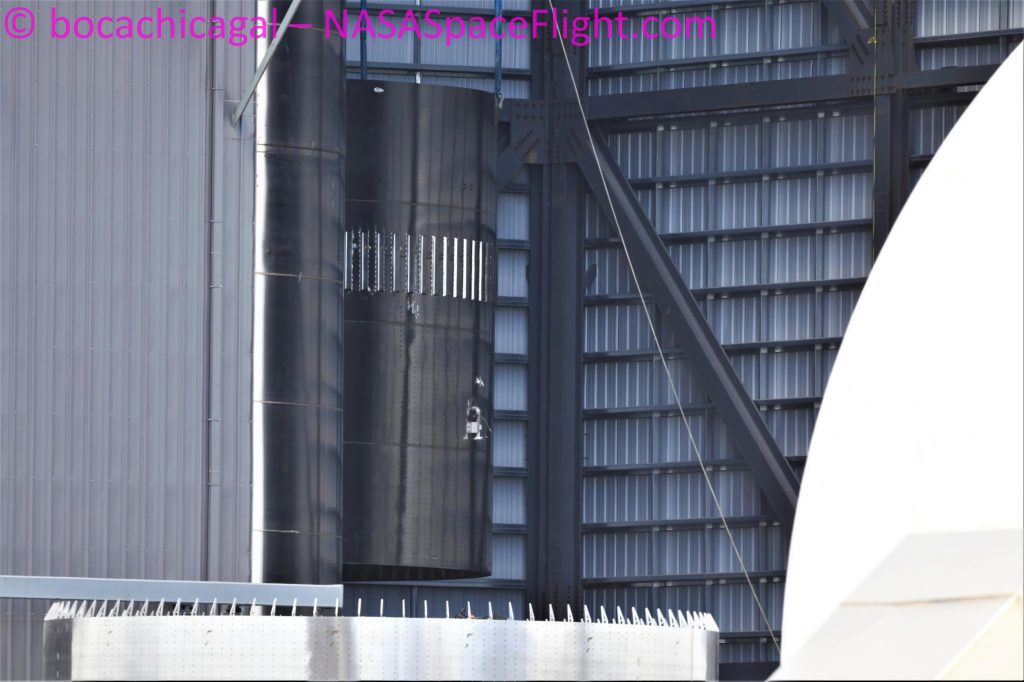
Meanwhile, as evidenced by the booster common dome section hanging in midair in the image above, the assembly of Super Heavy booster 4 (B4) – the same booster tasked with supporting Starship’s first orbital launch attempt – may have begun on July 15th. If the Super Heavy common dome assembly was simply being moved relocated, a separate four-ring section has been staged outside of the high bay to kick off Booster 4 stacking within the next few days.
All told, it’s not inconceivable that both of the first orbital-class Starship and Super Heavy prototypes will be fully assembled and ready for testing – integrated or otherwise – sometime in August.

News
Tesla launches its coolest gift idea ever just a few weeks after it was announced
“Gift one month of Full Self-Driving (Supervised), which allows the vehicle to drive itself almost anywhere with minimal intervention.”

Tesla has launched its coolest gift idea ever, just a few weeks after it was announced.
Tesla is now giving owners the opportunity to gift Full Self-Driving for one month to friends or family through a new gifting program that was suggested to the company last month.
The program will enable people to send a fellow Tesla owner one month of the company’s semi-autonomous driving software, helping them to experience the Full Self-Driving suite and potentially help Tesla gain them as a subscriber of the program, or even an outright purchase.
Tesla is going to allow owners to purchase an FSD Subscription for another owner for different month options
You’ll be able to gift FSD to someone! https://t.co/V29dhf5URj
— TESLARATI (@Teslarati) November 3, 2025
Tesla has officially launched the program on its Shop. Sending one month of Full Self-Driving costs $112:
“Gift one month of Full Self-Driving (Supervised), which allows the vehicle to drive itself almost anywhere with minimal intervention. All sales are final. Can only be purchased and redeemed in the U.S. This gift card is valued at $112.00 and is intended to cover the price of one month of FSD (Supervised), including up to 13% sales tax. It is not guaranteed to cover the full monthly price if pricing or tax rates change. This gift card can be stored in Tesla Wallet and redeemed toward FSD (Supervised) or any other Tesla product or service that accepts gift card payments.”
Tesla has done a great job of expanding Full Self-Driving access over the past few years, especially by offering things like the Subscription program, free trials through referrals, and now this gift card program.
Gifting Full Self-Driving is another iteration of Tesla’s “butts in seats” strategy, which is its belief that it can flip consumers to its vehicles and products by simply letting people experience them.
There is also a reason behind pushing Full Self-Driving so hard, and it has to do with CEO Elon Musk’s compensation package. One tranche requires Musk to achieve a certain number of active paid Full Self-Driving subscriptions.
More people who try the suite are likely to pay for it over the long term.
News
Tesla expands Robotaxi app access once again, this time on a global scale
Tesla said recently it plans to launch Robotaxi in Miami, Houston, Las Vegas, Phoenix, and Dallas.
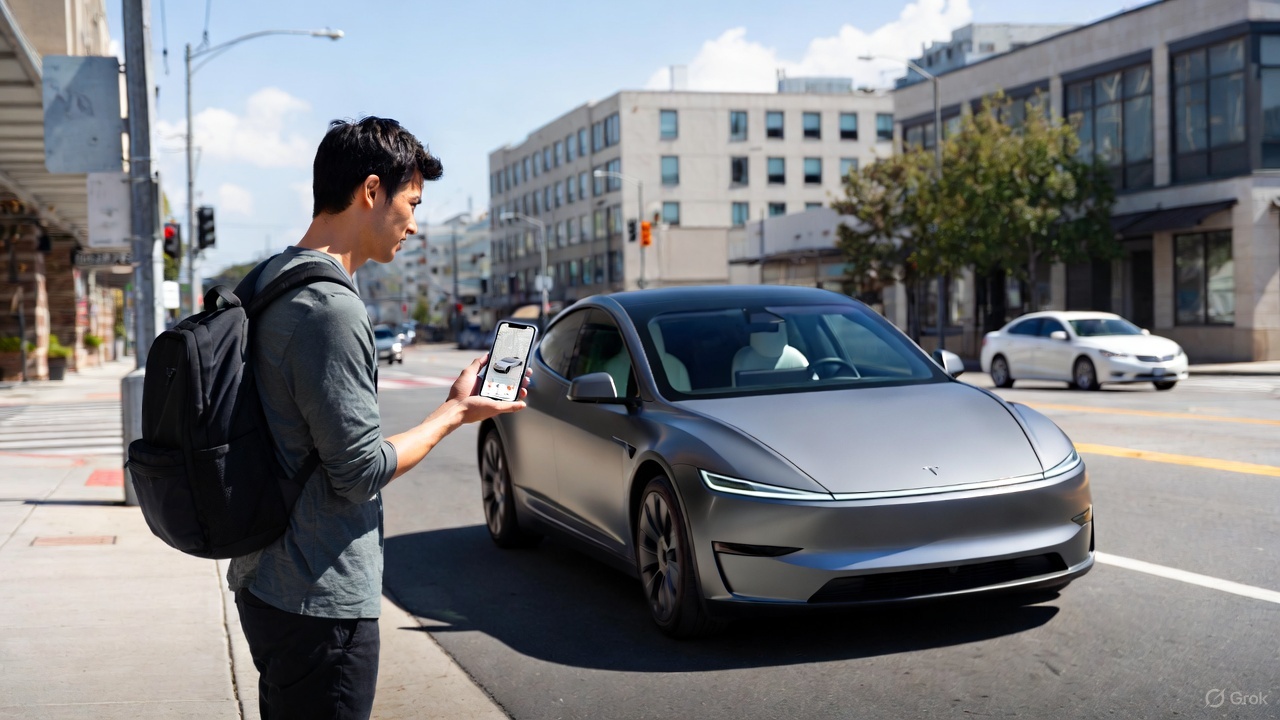
Tesla has expanded Robotaxi app access once again, but this time, it’s on a much broader scale as the company is offering the opportunity for those outside of North America to download the app.
Tesla Robotaxi is the company’s early-stage ride-hailing platform that is active in Texas, California, and Arizona, with more expansion within the United States planned for the near future.
Tesla said recently it plans to launch Robotaxi in Miami, Houston, Las Vegas, Phoenix, and Dallas.
The platform has massive potential, and Tesla is leaning on it to be a major contributor to even more disruption in the passenger transportation industry. So far, it has driven over 550,000 miles in total, with the vast majority of this coming from the Bay Area and Austin.
First Look at Tesla’s Robotaxi App: features, design, and more
However, Tesla is focusing primarily on rapid expansion, but most of this is reliant on the company’s ability to gain regulatory permission to operate the platform in various regions. The expansion plans go well outside of the U.S., as the company expanded the ability to download the app to more regions this past weekend.
So far, these are the areas it is available to download in:
- Japan
- Thailand
- Hong Kong
- South Korea
- Australia
- Taiwan
- Macau
- New Zealand
- Mexico
- U.S.
- Canada
Right now, while Tesla is focusing primarily on expansion, it is also working on other goals that have to do with making it more widely available to customers who want to grab a ride from a driverless vehicle.
One of the biggest goals it has is to eliminate safety monitors from its vehicles, which it currently utilizes in Austin in the passenger’s seat and in the driver’s seat in the Bay Area.
A few weeks ago, Tesla started implementing a new in-cabin data-sharing system, which will help support teams assist riders without anyone in the front of the car.
Tesla takes a step towards removal of Robotaxi service’s safety drivers
As Robotaxi expands into more regions, Tesla stands to gain tremendously through the deployment of the Full Self-Driving suite for personal cars, as well as driverless Robotaxis for those who are just hailing rides.
Things have gone well for Tesla in the early stages of the Robotaxi program, but expansion will truly be the test of how things operate going forward. Navigating local traffic laws and gaining approval from a regulatory standpoint will be the biggest hurdle to jump.
Investor's Corner
Tesla gets price target boost, but it’s not all sunshine and rainbows
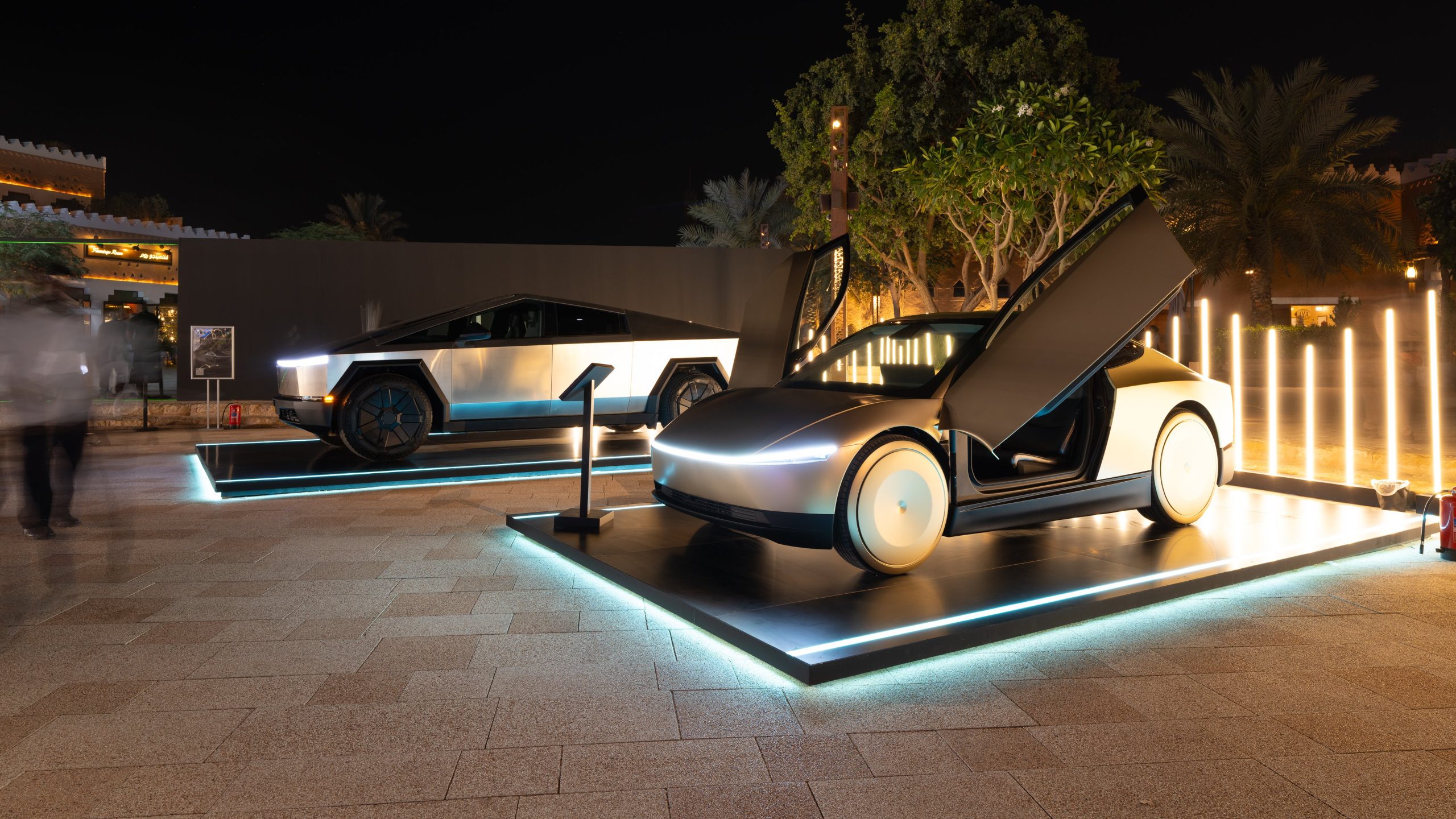
Tesla received a price target boost from Morgan Stanley, according to a new note on Monday morning, but there is some considerable caution also being communicated over the next year or so.
Morgan Stanley analyst Andrew Percoco took over Tesla coverage for the firm from longtime bull Adam Jonas, who appears to be focusing on embodied AI stocks and no longer automotive.
Percoco took over and immediately adjusted the price target for Tesla from $410 to $425, and changed its rating on shares from ‘Overweight’ to ‘Equal Weight.’
Percoco said he believes Tesla is the leading company in terms of electric vehicles, manufacturing, renewable energy, and real-world AI, so it deserves a premium valuation. However, he admits the high expectations for the company could provide for a “choppy trading environment” for the next year.
He wrote:
“However, high expectations on the latter have brought the stock closer to fair valuation. While it is well understood that Tesla is more than an auto manufacturer, we expect a choppy trading environment for the TSLA shares over the next 12 months, as we see downside to estimates, while the catalysts for its non-auto businesses appear priced at current levels.”
Percoco also added that if market cap hurdles are achieved, Morgan Stanley would reduce its price target by 7 percent.
Perhaps the biggest change with Percoco taking over the analysis for Jonas is how he will determine the value of each individual project. For example, he believes Optimus is worth about $60 per share of equity value.
He went on to describe the potential value of Full Self-Driving, highlighting its importance to the Tesla valuation:
“Full Self Driving (FSD) is the crown jewel of Tesla’s auto business; we believe that its leading-edge personal autonomous driving offering is a real game changer, and will remain a significant competitive advantage over its EV and non-EV peers. As Tesla continues to improve its platform with increased levels of autonomy (i.e., hands-off, eyes-off), it will revolutionize the personal driving experience. It remains to be seen if others will be able to keep pace.”
Additionally, Percoco outlined both bear and bull cases for the stock. He believes $860 per share, “which could be in play in the next 12 months if Tesla manages through the EV-downturn,” while also scaling Robotaxi, executing on unsupervised FSD, and scaling Optimus, is in play for the bull case.
Will Tesla thrive without the EV tax credit? Five reasons why they might
Meanwhile, the bear case is placed at $145 per share, and “assumes greater competition and margin pressure across all business lines, embedding zero value for humanoids, slowing the growth curve for Tesla’s robotaxi fleet to reflect regulatory challenges in scaling a vision-only perception stack, and lowering market share and margin profile for the autos and energy businesses.”
Currently, Tesla shares are trading at around $441.








